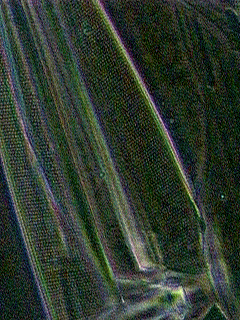More On Pores
The pores, also known as portules, are on the surface of the valve. There are two types of portules: fultoportulae-found only in order Thalassiosirales, and rimoportulae-which is universal. The structure of the fultoportulae is an external opening on the surface of the valve which may be extended into an elevated structure. The other end penetrates the silica matrix and is supported with two to five satallite pores. The function of these assisting pores is unknown. PICTURE pg 36. and pore on hd. The portules, themselves, function in the excretion of several materials, among them b-chitin fibrils. These fibrils are manufactured in the conical invaginations in the matrix, under the portule. This may be the anchoring site for the protoplast. The rimoportula is similar to the fultoportulae, except that it has a simpler inner structure. The rimoportula does not have satallite pores in the inner matrix. The rimoportula does, however, have some elaborate outer structures. In some species, the outer structure portrudes, bends, has slits, and in Aulacodiscus, the external tube is capped.
